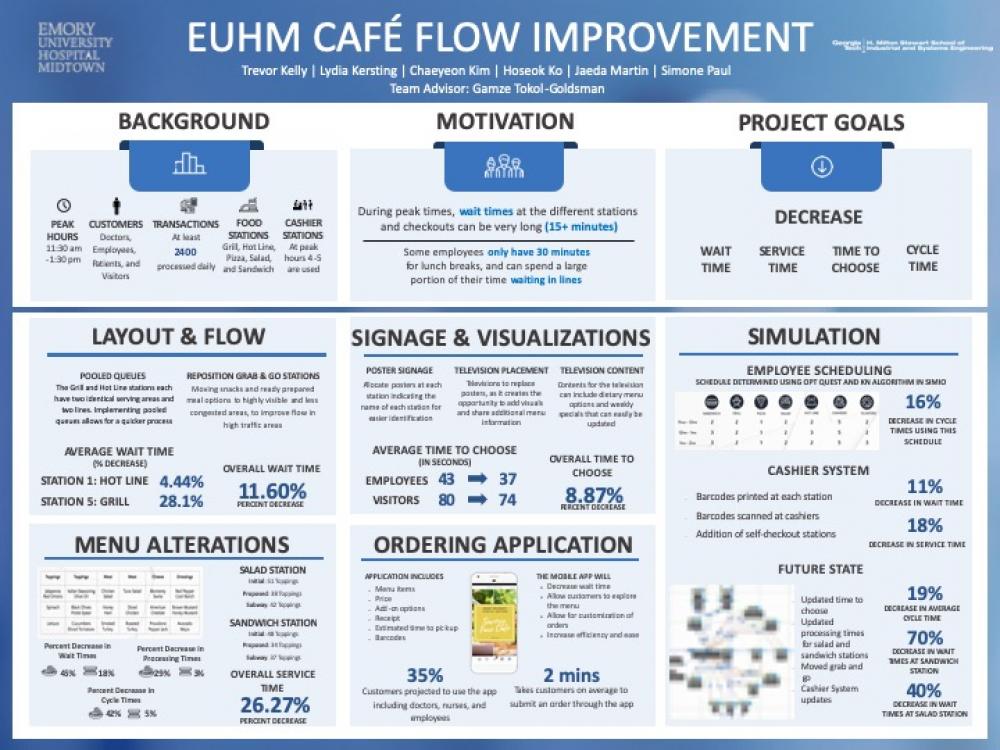Client Context
Emory University Hospital Midtown (EUHM), originally Emory Crawford Long Hospital, is a 511-bed acute care teaching hospital located in the ‘SoNo’ district of Atlanta, Georgia, United States, and affiliated with Emory Healthcare. EUHM has an in-house cafeteria, Savory Fare Café, that caters food options to hospital guests and staff daily between the hours of 6:00 AM and 8:15 PM. The cafeteria will serve on average more than 2,400 customers every weekday. Over 1,000 of these orders occur between the hours of 11:00 AM-2:00 PM which is considered “peak time.” The cafeteria serves employees as well as visitors to the hospital. EUHM prepares specialty meals including sandwiches and salads, fresh food from the grill, pizza, and hot line. Additionally, customers in a rush have a choice of multiple Grab-and-Go options. Each station has a different number of employees working to serve patrons. Employees have the option to ‘float’ between stations and jobs in order to meet the varying needs of the café. This senior design project will focus on providing recommendations to improve the customer experience as defined by overall cycle times to individuals who visit EUHM.
Project Objective
The cafeteria has five food stations (Sandwich, Salad, Pizza, Hot Line, Grill), four Grab and Go stations, a Chick-Fil-A stand, and various drink stations. Hot Line, Pizza, and Grill stations have a rotating menu that changes every four weeks and offers daily specials. The cafeteria typically uses between three to five of the six available cashier stations, depending on the time of day.
The narrow walkway along the back wall of the cafeteria experiences high congestion due to the long queues at the Hotline, Salad and Sandwich Stations. As a result of these long queues, this walkway is often blocked limiting customers’ access to Grab and Go Stations. The client wants to address this congestion and improve overall flow within the cafeteria by decreasing wait times at each station and at the checkout lines.
During peak hours, wait times of the different service stations and checkout lines can exceed 15 minutes due to high variability, although this is rare. Depending on what a customer wants to purchase, they may have to wait in lines at multiple stations before waiting in another line to checkout. Long wait times lead to the loss of potential productivity pertaining to employees who are unable to both acquire and eat their meals during their allotted lunchtime.
The primary goal of this project is to evaluate and improve customer flow by decreasing wait times at both the food stations and check-out lines. The phases are below:
Phase 1: System Flow (Layout & Flow and Signage & Visualization)
Phase 2: System Enhancements (Menu Alterations and Employee Scheduling)
Phase 3: System Efficiency (Cashier System and Ordering Process)
Project opportunities and deliverables are divided into three priority levels, based on which recommendations will affect the most people in the system. Therefore, the first priority is to analyze employee scheduling and address the needs of the cashier system. The second priority is to assess the layout and flow and provide signage and visualization. Lastly, make menu changes to the salad and sandwich station as well as recommend an ordering application for select individuals to use.
Design Strategy
- We determined the most popular menu items based on demand and net revenue for six months of sales data.
- We transferred the data from PDF files containing itemized receipts into a spreadsheet. This data was used for routing logic in the current state simulation model and to analyze what menu options were frequently ordered together to incentive grab and go options.
- We transferred the data from PDF files containing the end of day transaction reports into a spreadsheet. This data was used to determine cash versus card sales, daily number of transactions, and the number of employees that order from the cafeteria.
- We transferred the paper order slips of the Salad and Sandwich Stations into spreadsheets to analyze which toppings and order combinations were most often ordered.
- We conducted a time study and timed random customers coming into the cafeteria to determine, wait times, cycle times, service times, and time to choose.
- We researched Subway toppings and assembly-line methods to determine the types of meat, breads, cheeses, and how they build a sandwich. We utilized their process model as a best practice example.
- We timed customers at Kroger who went through the self-checkout lanes to collect wait and processing times. This data was used to benchmark future state simulation.
- We timed customers at Kroger who went through the cashier lanes to collect wait and service times. This data was used to determine the updated processing times at cashier stations once the barcode system is fully implemented.
Deliverables
We have 6 opportunities, and each opportunity has several deliverables.
Layout & Flow
- Pooled queue: The Hot Line and Grill stations had two identical food line setups with two separate queues. Combining these queues would help mitigate variability and reduce wait time
- Grab & Go station relocation: Improves visibility and accessibility of the main grab and go station
- Simulation model of current and future state system
Visualization & Signage
- Poster Signage: Helps direct customers to desired stations.
- Television allocation: Displays menu options at each station so customers do not have to look over each other to see what is being served. This will reduce the time to choose.
- Television contents: A template for the client to use to display menu options on the newly acquired televisions.
Ordering Process
- Application to place a food order through a mobile device. Specifically designed for employees of the hospital to account for capacity constraints and not overloading the queue.
Menu Alterations
- Performance of current menu items: Identifies which items are sold most by demand and net sales. The client can use this to make recommendations or decisions on which menu items to offer.
- Recommendations for Salad and Sandwich stations: Rearranging the salad and sandwich serving setup places popular menu items closer to the server and groups like toppings together for a seamless flow.
- Recommendations for Grab & Go items: offers different solutions including a specialty menu option for the week and incentivizing grab and go to encourage customers to visit the grab and go station instead of the salad and sandwich stations.
Employee Scheduling
- Recommendations from an optimization model to provide the optimal number of employees at each station as well as how many can act as floaters and move to where they are needed
Cashier System
- Barcode system implementation plan: recommends how to implement a barcode system to reduce wait and service time at the cashier stations.


